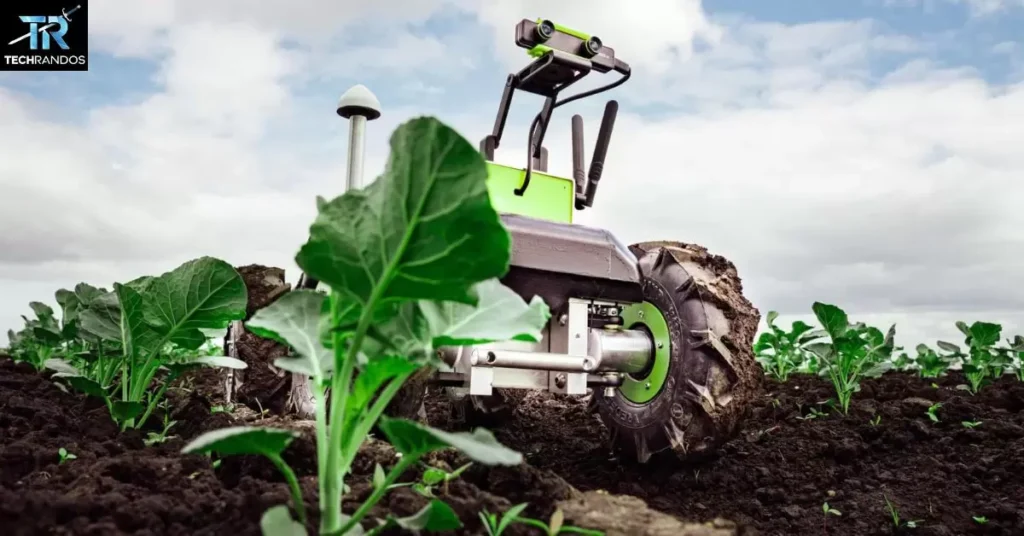Imagine fields tended by intelligent robots crops optimized through data analytics and supply chains streamlined with predictive modeling. This sci-fi vision? It is the present-day reality of simulated intelligence transforming agribusiness.
Simulated intelligence refers to computational systems that simulate intelligent behavior combining artificial intelligence (AI) machine learning (ML) and other cutting-edge technologies. While often used interchangeably with AI, simulated intelligence specifically models and replicates intelligent processes.
This article explores fascinating applications of simulated intelligence currently impacting agribusiness, from automated farming to data-driven decision-making. Prepare to have your ideas of modern agriculture radically shifted!
Precision Agriculture and Automated Farming

One of simulated intelligence’s most visible applications in agribusiness is precision agriculture – using AI, robotics, drones and machine learning to make farming operations smarter and more efficient.
Computer vision and deep learning algorithms allow autonomous drones and robots to precisely monitor crop health, soil conditions, and pest/disease infestations. They can analyze multispectral images far beyond human capabilities detecting minute changes invisible to the naked eye.
Based on this data these intelligent systems can then accurately apply fertilizers, pesticides, water and other treatments in a targeted need-based manner. This precision agronomics approach minimizes wastage of resources while maximizing yields.
For example, John Deere’s “See & Spray” technology uses computer vision to precisely identify and spray only weeds in a field, drastically reducing herbicide use compared to blanket spraying methods.
Beyond monitoring and input optimization, simulated intelligence is making entire farming operations autonomous through self-driving agricultural machinery like tractors, harvesters and sprayers. Guided by GPS, ML algorithms, and sensor data, these machines can operate around the clock with superhuman efficiency, even in harsh environments.
Here’s a quick look at how simulated intelligence powers automated farming solutions:
- Robotics: Autonomous robots, drones for field monitoring, input application
- Computer Vision: Visual data processing to detect plants, pests, soil conditions
- Machine Learning: Predictive analytics to optimize farming operations
- IoT Sensor Networks: Gathering real-time data on weather, soil moisture, etc.
We’ve gone from computer-aided to computer-guided, to now computer-automated agriculture says ag-tech expert Dr. Jonathan Barnes. This revolution is increasing productivity and sustainability like never before.
Predictive Analytics for Smarter Decision-Making

Beyond impacting on-farm activities, simulated intelligence is transforming agribusiness decision-making through the power of predictive analytics.
By crunching vast datasets on climate patterns, market trends, consumption habits and more AI/ML models can forecast future scenarios with incredible accuracy. This grantsfarmers distributors and suppliers the ability to make smarter data-driven decisions.
For crop management predictive models analyze historical data and real-time inputs like weather soil conditions crop phenotypes etc. to optimize planting schedules, irrigation patterns and harvesting for maximum yields.
Supply chain optimization is another key application helping agribusiness giants like Monsanto make projections on shifting consumer demand and market prices. Their AI system “FutureBlend” allows planning of production inventory and logistics for peak efficiency and cost savings.
| Predictive Analytics Use Case | Key Data Inputs | Sample Outputs |
| Crop Management | Weather, soil, phenotypes | Planting schedules, irrigation plans |
| Demand Forecasting | Market data, demographic trends | Procurement, inventory needs |
| Logistics Optimization | Supplier data, routing, traffic | Transport routing, warehousing |
As Dr. David Rolnick, CTO of agtech firm CropProphecy notes, “Accurate predictive modeling allows us to peer into the future and make decisions that were simply impossible before the era of big data and simulated intelligence.”
Recommended Article: Harnessing Computer-Based Intelligence for Effective Environmental Change Arrangements
Simulated Intelligence in Agribusiness: Tackling Sustainability Challenges
One of simulated intelligence’s most promising applications is its potential to make agriculture more eco-friendly and sustainable. Precision agronomics coupled with predictive analytics allows optimizing inputs like water and chemicals for crops.
Take targeted fertilizer application using drones and robots. By mapping nutrient deficiencies and only applying fertilizer where needed these systems can reduce excess fertilizer runoff that pollutes groundwater compared to broadcast spreading methods.
Similarly, Intelligent irrigation control based on hyper-local weather predictions, soil sensors and crop needs minimizes water waste. According to MIT researchers this could reduce agricultural water usage by 30% globally!
The sustainability benefits extend beyond reducing chemical/resource consumption. Vertical farming powered by AI/robotics could revolutionize urban agriculture. Plant factories managed by smart systems can produce food year-round with a fraction of the land, water and environmental impact of traditional farming.
“We must urgently address agriculture’s environmental footprint to stave off climate catastrophe,” warns Dr. Shruthi Iyer, Chief Research Scientist at Gro-X Agritech. “Simulated intelligence provides our best toolkit for transforming into a sustainable, resource-efficient industry.”
Innovative solutions powered by simulated intelligence are ushering a new era of productive yet eco-friendly agriculture capable of feeding our growing global population.
The Future of Simulated Intelligence in Agriculture

While the current simulated intelligence applications in agribusiness are impressive experts insist we’re just scratching the surface. Research is underway to develop even more advanced solutions:
Autonomous Greenhouses: AI-controlled environments optimizing factors like lighting, temperature humidity and nutrition for year-round, hyper-efficient indoor farming. Robots handle planting monitoring and harvesting.
Crop Breeding and Gene Editing: Machine learning driving accelerated breeding of climate-resilient, high-yield crop varieties using gene editing and DNA marker analysis.
Precision Livestock Management: Applying simulated intelligence for automated monitoring, health diagnostics feed optimization and micro-climate control in dairy/poultry farming.
Intelligent Food Production: Computer vision and robotics to automate sorting, packaging, processing and distribution of agricultural products based on intelligent quality control.
However, ag-tech innovators warn there are still barriers to widespread simulated intelligence adoption:
- Cost and Accessibility: Cutting-edge hardware/software require major investments
- Training & Talent Gaps: Shortage of data scientists, agricultural AI/robotics experts
- Integration Challenges: Merging new technologies with existing infrastructure
- Trust and Ethics Concerns: Addressing fears of job displacement, AI failures etc.
Despite the hurdles, industry leaders are confident simulated intelligence will become essential across the agriculture and food production chain.
Just as the Green Revolution democratized crop yields, simulated intelligence represents the next revolutionary pivot towards productive and sustainable agriculture, predicts Dr. Mae Jemison, multi-faceted engineer and former NASA astronaut.
However, achieving its potential requires multidisciplinary collaboration between technologists, agronomists, ethicists, economists and policymakers. It’s an all-hands-on-deck effort to ensure global food security.
Frequently Asked Questions
What is simulated intelligence?
Simulated intelligence refers to computational systems that model and replicate intelligent behavior by combining artificial intelligence (AI), machine learning (ML), robotics, and other cutting-edge technologies. It simulates human-like intelligence to solve complex problems.
How is simulated intelligence different from artificial intelligence?
While often used interchangeably, simulated intelligence specifically focuses on simulating intelligent processes and behavior through AI/ML systems. Artificial intelligence is a broader field that also includes rule-based systems and knowledge representation.
What are some applications of simulated intelligence in agribusiness?
Some key applications include:
- Precision agriculture using drones, robots for crop monitoring, targeted input application
- Predictive analytics for forecasting crop yields, market trends, supply chain optimization
- Autonomous farming machinery like self-driving tractors
- Vertical farming and controlled environment agriculture
- Accelerated crop breeding and genetic optimization
How does simulated intelligence help make agriculture more sustainable?
By precisely mapping resource needs and optimizing inputs like water, fertilizers, simulated intelligence solutions can drastically reduce waste and environmental impact compared to traditional farming methods. It also enables eco-friendly vertical farming techniques.
What are some challenges in adopting simulated intelligence for agribusiness?
Key hurdles include the high costs of cutting-edge hardware/software, talent gaps in agricultural AI/robotics, integration with existing infrastructure, and ethical concerns around job displacement or AI failures. Building trust is crucial.
What does the future hold for simulated intelligence in agriculture?
Advanced solutions like autonomous greenhouses, intelligent food production lines, hyper-precise livestock management and accelerated crop breeding are on the horizon. However, multidisciplinary collaboration between agriculture, technology and ethics experts is needed to realize its full potential responsibly.
Conclusion
Simulated intelligence is no longer just theory – it’s an essential tool driving efficiency and sustainability in modern agribusiness. From robotic drones optimizing inputs to predictive analytics streamlining supply chains AI/ML is redefining how we cultivate crops and bring food to tables worldwide.
As these technologies continue advancing, they’ll reshape agriculture while ensuring plentiful, eco-friendly food supply for our growing population. By harnessing simulated intelligence’s capabilities responsibly and ethically the agriculture industry can meet humanity’s needs while protecting our planet’s precious resources.
The seeds of this transformation have already taken root. Now it’s up to us to carefully nurture and cultivate simulated intelligence’s boundless potential in creating a smarter, more sustainable agribusiness model for the 21st century.











